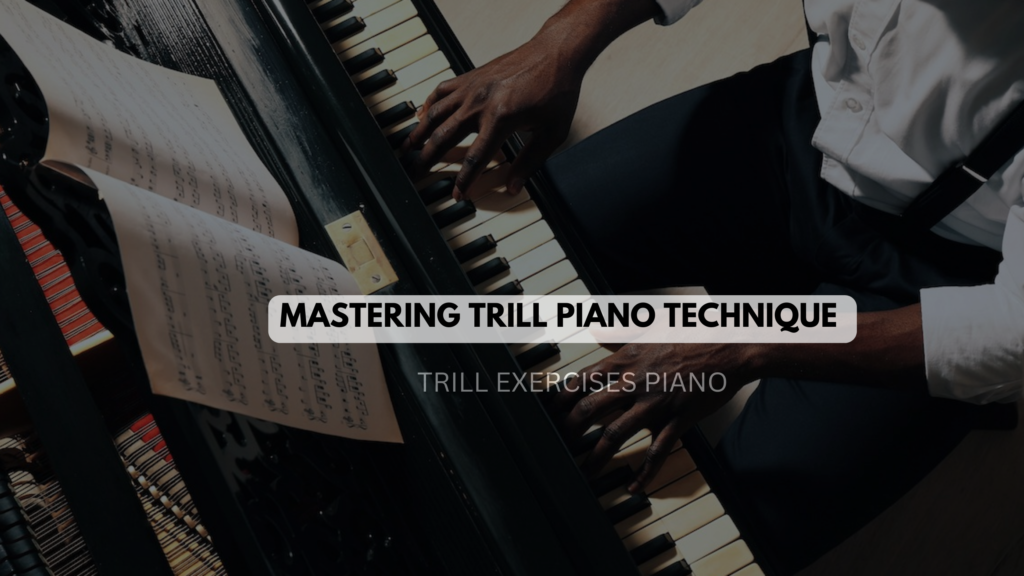Trills – those rapid flickers of melody that add a spark of virtuosity to countless piano pieces – can be both enchanting and intimidating. Mastering them requires dedication, but the rewards are well worth the effort. This comprehensive guide unlocks the secrets of trill exercises for piano, empowering you to tackle even the most demanding passages with confidence and control.
Understanding Trills
Before diving into exercises, let’s demystify the trill itself. A trill involves the rapid alternation of two adjacent notes, creating a vibrating effect. Depending on the context, trills can last for a single beat, several measures, or anything in between. They add ornamentation, texture, and even emotional depth to music, making them a crucial skill for any aspiring pianist.
Essential Technique Tips
Now, let’s equip ourselves with the essential technical tools for conquering trills:
- Finger Independence: The key to a smooth trill lies in independent finger movement. Practice exercises that isolate individual fingers, like scales and arpeggios, to build agility and control.
- Wrist Position: Maintain a relaxed wrist throughout the trill. Tension here can hinder finger movement and create unevenness. Imagine your wrist as a hinge, guiding the fingers while remaining flexible.
- Touch and Tone: Aim for a light, even touch on both notes of the trill. Focus on producing a clear, singing tone rather than hammering the keys.
Progressive Trill Exercises

Now, it’s time to put theory into practice with a variety of trill exercises:
- Slow and Even: Start with a manageable tempo and focus on playing both notes with equal weight and spacing. Use a metronome to maintain a consistent rhythm.
- Accentuated Trills: Introduce dynamic variations by accenting one note of the trill slightly. This adds rhythmic interest and helps with finger independence.
- Legato Trills: Connect the trill seamlessly to the surrounding notes. Avoid harsh accents or gaps between the trill and surrounding melody.
- Expanding Intervals: Challenge yourself with trills spanning wider intervals, like thirds, fourths, and even octaves. This requires additional finger reach and coordination.
- Double Trills: For an extra challenge, try playing two simultaneous trills, one in each hand. This demands exceptional finger independence and coordination.
Practice Strategies for Success
Effective practice is crucial for mastering trills. Here are some key strategies:
- Start Slow and Gradually Increase Speed: Don’t rush. Focus on accuracy and evenness before attempting high speeds. Build your speed gradually to maintain control and avoid fatigue.
- Short Bursts of Practice: Instead of marathon sessions, practice trills in shorter, focused bursts throughout the day. This helps maintain concentration and prevent muscle fatigue.
- Vary the Exercises: Don’t get stuck in a rut. Experiment with different trill exercises, tempos, and dynamics to keep your practice engaging and effective.
- Record Yourself: Recording your playing can reveal subtle flaws in your technique that you might miss while practicing. Listen back to your recordings and identify areas for improvement.
- Seek Guidance: Don’t hesitate to seek guidance from a qualified piano teacher. They can provide personalized feedback, tailor exercises to your specific needs, and help you overcome any challenges you encounter.
Beyond the Basics

Mastering the fundamentals is just the beginning. Once you’ve gained confidence with basic trills, explore these advanced techniques to further elevate your playing:
- Mordents: Short bursts of trills adding ornamentation and emphasis to melodic lines.
- Turnarounds: Rapidly ascending and descending trills used for dramatic effect.
- Octave Trills: Trills spanning an octave, demanding impressive finger reach and control.
- Double Notes with Trills: Playing a separate melody line while incorporating trills, requiring exceptional dexterity and focus.
Conclusion
The journey to conquering trills may be challenging, but the rewards are immeasurable. With dedication, effective practice, and the right techniques, you can transform these once-feared ornaments into tools of musical expression, adding a touch of virtuosity and elegance to your piano playing.
So, embrace the challenge, delve into the world of trill exercises, and unlock the magic at your fingertips!
Resources & References
- The Piano Guild: https://pianoguild.com/
- Piano World: https://forum.pianoworld.com/
- Grusin Music: https://www.youtube.com/channel/UC62Uw1nJ5yd-EVey8l9FQyg
- Piano Marvel: https://pianomarvel.com/article/getting-started-how-to-learn-the-piano-on-your-own
FAQs about Trill Exercises for Piano
How important are trill exercises for piano playing?
Trill exercises are crucial for developing finger independence, agility, and control. They strengthen individual fingers, improve coordination between fingers, and refine touch and tone. Mastering trills unlocks the ability to tackle complex passages with confidence and adds a touch of virtuosity to your playing.
What are some beginner-friendly trill exercises?
Start with slow, even trills between adjacent notes using fingers 1 and 2 or 2 and 3. Focus on maintaining equal weight and spacing between the notes, using a metronome for consistent rhythm. Gradually increase speed while maintaining accuracy and control. Explore exercises with different finger combinations, intervals, and dynamics as you progress.
What common mistakes should I avoid when practicing trills?
Rushing: Don’t get caught up in speed. Focus on clean technique and evenness before attempting high tempos. Tension: Maintain a relaxed wrist and fingers. Tense muscles hinder finger movement and create unevenness. Uneven touch: Aim for a light, consistent touch on both notes of the trill.
Avoid hammering the keys. Neglecting surrounding notes: Ensure smooth transitions between the trill and the surrounding melody. Avoid harsh accents or gaps.
How often should I practice trill exercises?
Incorporate short bursts of trill practice throughout your daily routine rather than marathon sessions. This helps maintain focus and prevent fatigue. Aim for 5-10 minutes of dedicated trill practice several times a day for optimal results.
Should I use a metronome when practicing trills?
A metronome is a valuable tool for developing consistent rhythm and tempo control. Start with a slow tempo and gradually increase it while maintaining accuracy. Use the metronome to ensure even spacing between the trill notes.
When should I seek help from a piano teacher?
If you encounter difficulties overcoming technical challenges, feel stuck in your practice, or have concerns about your technique, don’t hesitate to seek guidance from a qualified piano teacher. They can provide personalized feedback, tailor exercises to your specific needs, and help you troubleshoot any obstacles you face.


